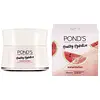What's inside
What's inside
 Key Ingredients
Key Ingredients

No key ingredients
 Benefits
Benefits

 Concerns
Concerns

 Ingredients Side-by-side
Ingredients Side-by-side

Pentaerythrityl Tetraethylhexanoate
EmollientIsopropyl Palmitate
EmollientPentaerythrityl Tetraisostearate
EmollientC12-15 Alkyl Benzoate
AntimicrobialCaprylic/Capric Triglyceride
MaskingPEG-20 Glyceryl Triisostearate
EmollientPEG-8 Isostearate
EmulsifyingDextrin Palmitate
EmulsifyingParfum
MaskingDextrin Palmitate/Ethylhexanoate
EmulsifyingGlyceryl Behenate/Eicosadioate
EmollientLimnanthes Alba Seed Oil
Skin ConditioningButyrospermum Parkii Butter
Skin ConditioningOryza Sativa Bran Oil
EmollientPentaerythrityl Tetraethylhexanoate, Isopropyl Palmitate, Pentaerythrityl Tetraisostearate, C12-15 Alkyl Benzoate, Caprylic/Capric Triglyceride, PEG-20 Glyceryl Triisostearate, PEG-8 Isostearate, Dextrin Palmitate, Parfum, Dextrin Palmitate/Ethylhexanoate, Glyceryl Behenate/Eicosadioate, Limnanthes Alba Seed Oil, Butyrospermum Parkii Butter, Oryza Sativa Bran Oil
Water
Skin ConditioningDimethicone
EmollientGlycerin
HumectantButylene Glycol
HumectantAmmonium Acryloyldimethyltaurate/Vp Copolymer
Isohexadecane
EmollientDimethicone/Vinyl Dimethicone Crosspolymer
Skin ConditioningCaprylic/Capric Triglyceride
MaskingCitrullus Lanatus Fruit Extract
Skin ConditioningTocopheryl Acetate
AntioxidantAmmonium Acryloyldimethyltaurate/Beheneth-25 Methacrylate Crosspolymer
Emulsion StabilisingCetearyl Alcohol
EmollientBenzophenone-4
UV AbsorberAllantoin
Skin ConditioningLinoleamidopropyl Pg-Dimonium Chloride Phosphate
Propylene Glycol
HumectantStearic Acid
CleansingParfum
MaskingNiacinamide
SmoothingDimethiconol
EmollientCetearyl Glucoside
EmulsifyingDisodium EDTA
Sodium PCA
HumectantBHT
AntioxidantPropanediol
SolventC12-14 Pareth-12
EmulsifyingT-Butyl Alcohol
PerfumingSodium Hydroxide
BufferingPEG-4 Laurate
EmulsifyingPEG-4 Dilaurate
EmulsifyingPhenoxyethanol
PreservativeHydroxystearic Acid
CleansingPEG-4
HumectantIodopropynyl Butylcarbamate
PreservativeBenzoic Acid
MaskingMethylparaben
PreservativeChlorphenesin
AntimicrobialGlucose
HumectantSodium Ascorbyl Phosphate
AntioxidantSodium Carbonate
BufferingCyclotetrasiloxane
EmollientPalmitic Acid
EmollientArachidic Acid
CleansingSodium Chloride
MaskingSodium Sulfate
CI 14700
Cosmetic ColorantWater, Dimethicone, Glycerin, Butylene Glycol, Ammonium Acryloyldimethyltaurate/Vp Copolymer, Isohexadecane, Dimethicone/Vinyl Dimethicone Crosspolymer, Caprylic/Capric Triglyceride, Citrullus Lanatus Fruit Extract, Tocopheryl Acetate, Ammonium Acryloyldimethyltaurate/Beheneth-25 Methacrylate Crosspolymer, Cetearyl Alcohol, Benzophenone-4, Allantoin, Linoleamidopropyl Pg-Dimonium Chloride Phosphate, Propylene Glycol, Stearic Acid, Parfum, Niacinamide, Dimethiconol, Cetearyl Glucoside, Disodium EDTA, Sodium PCA, BHT, Propanediol, C12-14 Pareth-12, T-Butyl Alcohol, Sodium Hydroxide, PEG-4 Laurate, PEG-4 Dilaurate, Phenoxyethanol, Hydroxystearic Acid, PEG-4, Iodopropynyl Butylcarbamate, Benzoic Acid, Methylparaben, Chlorphenesin, Glucose, Sodium Ascorbyl Phosphate, Sodium Carbonate, Cyclotetrasiloxane, Palmitic Acid, Arachidic Acid, Sodium Chloride, Sodium Sulfate, CI 14700
 Reviews
Reviews

Ingredients Explained
These ingredients are found in both products.
Ingredients higher up in an ingredient list are typically present in a larger amount.
This ingredient is an emollient, solvent, and texture enhancer. It is considered a skin-softener by helping the skin prevent moisture loss.
It helps thicken a product's formula and makes it easier to spread by dissolving clumping compounds.
Caprylic Triglyceride is made by combining glycerin with coconut oil, forming a clear liquid.
While there is an assumption Caprylic Triglyceride can clog pores due to it being derived from coconut oil, there is no research supporting this.
Learn more about Caprylic/Capric TriglycerideParfum is a catch-all term for an ingredient or more that is used to give a scent to products.
Also called "fragrance", this ingredient can be a blend of hundreds of chemicals or plant oils. This means every product with "fragrance" or "parfum" in the ingredients list is a different mixture.
For instance, Habanolide is a proprietary trade name for a specific aroma chemical. When used as a fragrance ingredient in cosmetics, most aroma chemicals fall under the broad labeling category of “FRAGRANCE” or “PARFUM” according to EU and US regulations.
The term 'parfum' or 'fragrance' is not regulated in many countries. In many cases, it is up to the brand to define this term.
For instance, many brands choose to label themselves as "fragrance-free" because they are not using synthetic fragrances. However, their products may still contain ingredients such as essential oils that are considered a fragrance by INCI standards.
One example is Calendula flower extract. Calendula is an essential oil that still imparts a scent or 'fragrance'.
Depending on the blend, the ingredients in the mixture can cause allergies and sensitivities on the skin. Some ingredients that are known EU allergens include linalool and citronellol.
Parfum can also be used to mask or cover an unpleasant scent.
The bottom line is: not all fragrances/parfum/ingredients are created equally. If you are worried about fragrances, we recommend taking a closer look at an ingredient. And of course, we always recommend speaking with a professional.
Learn more about Parfum